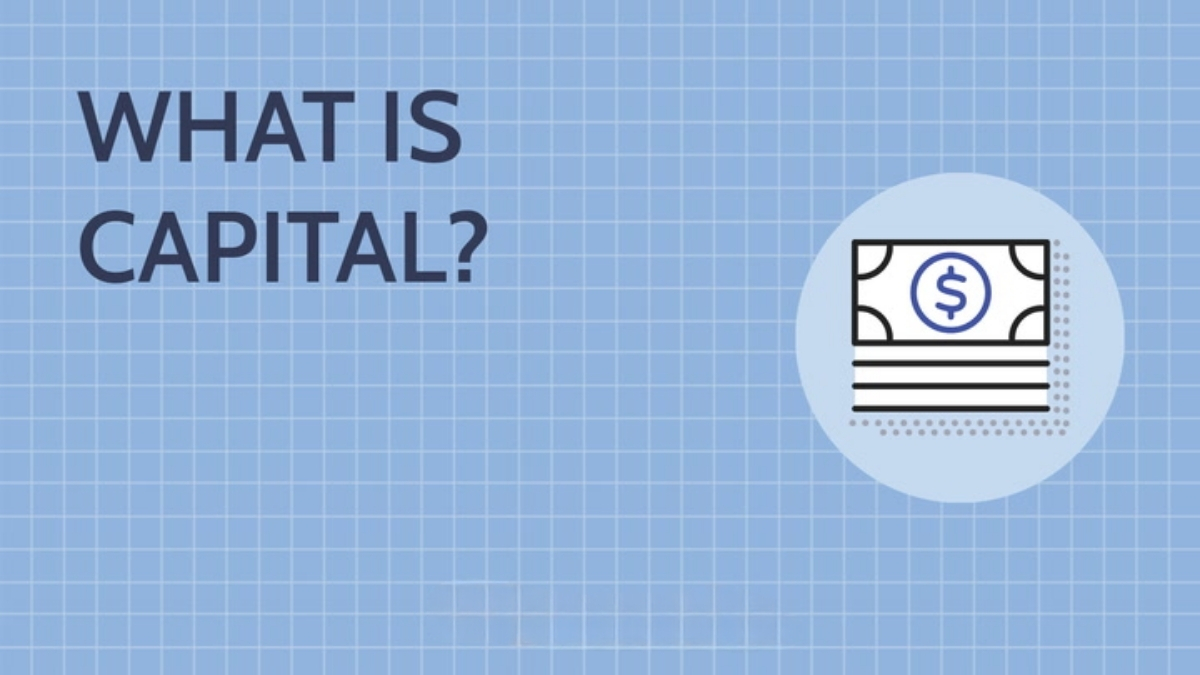What is capital, and why are modern world economies highly dependent on it. Read the article to know everything about capital and what is capital in a business.
“Capital.” Something we might have heard often in the news or a business conversation. Capital is more than just an idea; it is a powerful tool regulating world economies. In the modern world, everything is capital, and the value it gives is what makes people rich.
You might be confused as to “what is capital?” The answer to the question is quite complex. Because as societies have become more tangled up in structures, there is no single definition to the word “capital.”
However, you should be aware that capital is an essential aspect of living in the modern world, especially in business. Capital plays an important role in determining the success of a company. It is a big structure that upholds most of the economy of the world. This is why it is important to know what is capital in a business.
To find out what is capital, here is a complete guide for you to read:
What is Capital?
Capital comes from the Latin word “caput,” which has various meanings, but the most relevant is “stocks,” or the result of what one yields. According to another source, capital comes from “capitale,” which means “an individual’s wealth.” It used to be called “Capitol” in old English, now it is called “Capital.”
Theoretically, Capital is defined as anything that holds value or will prove to be valuable to the owner. It should generate wealth for the owner as time passes. For example, machinery or land that can produce something for the owner to give monetary benefit is referred to as Capital.
Capital is not something constant in its worth; rather, it increases with time. Capital is not limited to the monetary aspect of value; instead, it can be worthy in social, political, or intellectual aspects as well. In the modern world, the definition of what is capital has become more diverse than before.
History of capital
Capital is not a new concept; in fact, it has existed as long as the industrial revolution. When you read the history of the world, societies are divided into five progressive times: hunting and gathering, horticulture/ pastoralism, agrarian, industrialization, and finally, digital technology. Capital began somewhere in between agrarian society and industrialization. The first country to adopt capital and be known as the “capitalist” country was Britain. Slowly, it expanded its reach to other countries.
The most defining moment for Capital was when it further developed the industrial societies through exploitation and land ownership until it became a web-like structure that is now too difficult to untangle. Today, the world is intact by capital, and every country would be on the verge of crisis without it.
Karl Marx
When you ask the question, “what is capital?” It takes us to a whole new world of definition that was introduced to us by the philosopher and sociologist Karl Marx. He wrote a book called Das Kapital, which is considered to be one of the greatest books in the history of the world.
As industries were being set at a very large scale around the world in the 19th century, Marx studied this phenomenon of where the society was progressing towards. Thus, he came up with the concept of “Capitalism,” which means the study of Capital. Marx believed the Capital had influenced the world deeper than the people thought.
In greed of Capital, the society got divided into two main categories: Bourgeois and Proletarians. The bourgeoisie is the higher class that builds their wealth on capital, and the Proletariat is the working class that was exploited to build that wealth for them. So, in a way, the capital is created by using others’ labor.
He defines capital as “moneyed wealth, as the capital of the merchant and usurer.” However, the capital is not monetary anymore, it is a social relation that deprives people’s control over production and exploits them with low-income. This was a social criticism given by Marx over Capital.
Capital is a structure that divides a society with only small people owning it and others working for it. In the modern world, capital can be referred to as the millionaire or billionaire companies under which thousands of people work to create wealth for one single person or a small group of people.
What is capital in a business?
Capital, in the business aspect, is a sum of financial assets or values that are produced by using goods or services. In short, Capital is liquid assets that can bring value inflow.
Individuals or companies hold Capital and invest it into companies that use that asset to produce a product or service that brings profit in return. The capital in business can be of three types, the number of assets owned, the net worth of the company specified on the balance sheet or the stock of a company owned by someone.
In short, if someone asks, what is capital? It simply means funds for daily use and operations to run a company and produce revenue for the future.
Why is it important in business?
Capital is an important aspect of a business. You cannot run a company if you do not have enough capital to afford the expenses. A company needs to have an adequate amount of assets to survive the market or compete against its rivals.
Business managers and the leadership of a company put a lot of effort into convincing investors or finding other financial ways to increase their capital on a daily basis to maintain their status in the market. So, capital is crucial for business.
If you are thinking of starting a business, you should be familiar with this concept of capital very clearly. Although it is complex, you can answer the question of what is capital in detail through this article.
How is capital created?
Capital is used to create more capital. In business and economics, the companies use capital to generate products through human labor or other means of production and sell it for higher capital. The process is an ongoing cycle, and this is how capital is created in the modern world.
With technological and mechanical advancement, machines and computers are used to create products or services that can be sold to bring capital to the production company.
The created capital is not limited to companies. There are economies of different companies involved as well. Economists calculate the capital of the country to determine their economic growth and how they can improve their strategies to improve the growth. In businesses, the financial capital is calculated to understand the status of a company. Similarly, in other sectors, the capital is created in different ways, but the purpose is to give back more capital.
Types
Now that you know what is capital, you should know various types of capital. As mentioned before, the modern world of the economy is a web-like structure where capital plays an important role. Capital is not just one thing; instead, it has types.
Here are types of capital that you should know:
Financial capital
Financial capital comes under the business industry. It is a type of capital that gives financial wealth to an individual or company. It involves the finances needed to produce more capital for the lenders. This type of capital is further divided into categories: debt, equity, and working capital.
Debt capital
Debt is a type of financial capital in which funds are borrowed, and they need to be paid back with interest. The interest rate is set by the lender. So, as the person pays back, they have to pay the amount with interest as well.
The borrowed money is spent on making assets and producing services that, in return, give profit to the company. For example, if a company needs funds to complete a project, it can loan money from the bank at an interest rate. The bank calculates the probability of success of the project or company and gives it to the company. Once the company earns enough capital, they pay back the loan with interest rate included.
Equity capital
Equity is ownership of a certain percentage of a company or stock ownership to fund the company. The revenue of the company produced due to those funds profits the inventors in return. You do not need to pay the investors back; instead, they own the stocks to the company.
In simple words, shares of a company are given to the investor. So, when the company earns revenue, the investor earns the profit through the percentage of the share. The company can choose to give in the form of dividends as well. For example, a bank is newly opened and needs funds to avoid liquidation, so they sell dividends to investors that they can use later in the future to earn the double amount invested.
Maximizing Liquidity: Unveiling the Power of Working Capital
In assessing working capital, subtract current liabilities from assets to gauge liquidity for short-term operations, pivotal for navigating market fluctuations.
A robust working capital bolsters a company’s resilience, providing a safety net during financial turmoil and enticing investors seeking stable ventures.
This financial metric holds particular significance in the retail realm, where sudden shifts in demand necessitate ample resources for seamless operations and sustained supplier relationships.
Human capital
Human capital is a type of capital that uses humans to produce products or services to build assets. The companies pay a certain amount of money for their skills to profit off the products. This is different from the financial capital in which you “own” the assets.
You simply hire humans to produce revenue for the owner. This can be through intellectual or talent/skills. In intellectual capital, the company uses people’s ideas and strategies to profit off, while in skills, they use people’s physical strength to produce assets.
For example, the creativity of a person used to create something and sell it to the customers that profits the company to create capital.
Manufactured capital
Manufactured capital is different from human capital. In manufactured capital, the source of production is the machinery built by humans to create products for humans. In other words, it has no human involvement but provides goods or services to humans to create capital for the company.
The robotic machinery used to make cars or the system of robots that work together to manufacture and package a product to be used by humans comes under manufactured capital.
For manufactured capital, a company needs enough capital to buy machinery and then produce enough goods that can profit and increase the revenue of the company.
Economic capital
Economic capital is the ability of a company to afford risks. This type of capital calculates how much capital a company might need to maintain its status in the market and remain stable. This capital is estimated by the internal staff of the company by taking into account all the valuable assets it owns.
Economic capital is also used to convince inventors and other potential clients about the worth of a company. It is considered to be more practical and authentic. By measuring the amount of loss, frequency of loss, financial confidence, and economic capital, the company is able to improve its regulation, or investors are convinced to invest.
This type of capital is similar to financial capital because it involves finances and accounting but is slightly different as well.
Natural capital
Natural capital is a type that uses natural resources to produce something. Natural resources like solar power, water, plants, crops, and wind are used to increase the revenue of the company. The factories or production place is placed in a geological location that suits them and produces products.
It is not necessary for a company to own them as assets, but their revenue should increase with time. For example, a company uses natural resources to create fuel and sell it to customers, or a company sets up a structure that absorbs carbon dioxide in the air for the environment’s sustainability.
Most natural capital is generated from agriculture production. Importing crops and producing sugar mills is considered profitable because food is a basic necessity, and everyone needs to buy it at all costs. However, some companies also harm the natural environment by using the resources, then the government and policymakers are responsible for controlling them.
Trading capital
Trading capital operates on a daily basis in which the public is involved in investment to earn profit by buying or selling various assets in the market. The trading market sets a certain limit that each individual must have to be able to trade and afford any loss on the market.
This is the most common capital that many people choose to do, to earn profit and build their wealth. Trading and investment have brought a lot of capital to traders, but since the market trends change daily, it comes with a risk as well.
Cultural capital
Cultural capital is different from other above-mentioned capital. It is related to the culture and heritage of an individual. The goods, tangible or intangible, collected for years or during a lifetime by ancestors that can be valuable to the world, come under cultural capital.
The capital goods can be artifacts, historical pieces, ancient tools, or any other good that shows an important aspect of culture. This type of social capital can also be earned through behavior or mannerism that signifies your socioeconomic status in society.
All these types of capital play an important role in the sustainability of economic development for a country. They are the pillars of the economy that maintain the structure for years.
Difference between money and capital
Money and capital are often confused for being the same thing; they are entirely different from one another. Money is a simple means to exchange goods or services. You pay money physically or virtually to buy something. However, capital is not the same as money.
Capital is any form of asset that has a value attached to it, and that value increases with time. There is a certain cost to gain that capital. For example, if it is financial capital, then it will be in the form of interest. For equity capital, the capital is divided among a bunch of shareholders.
What is a capital asset?
A capital asset is a broader term in finances that refers to assets owned by an individual or company that are not liquid. Not being liquid means you cannot turn an asset into cash readily; you need to sell that asset to get the money. An asset is something that is kept in possession for at least a year and is not intended to be sold simply by money.
For example, real estate ownership or car ownership is individual capital assets. A production company might have capital assets like machinery or other technological devices that help produce certain services or goods.
What is capital in economics?
Now that you know what is capital. You should know why it is vital in economics. When you are an economics student, the first you study is capital. There is a long discussion and proper course to understand it because of its diversity and importance in the modern world.
Economics defines capital as one of the factors of production in society. Before industrialization, it was not much known to people because they focused on farming more. But the industrial revolution and the concept of trading & investment brought the importance of capital in economics.
In economics, capital is what regulates a country or a company. It is not a land or non-living entity; instead, it is something humans create for humans or things that can help humans create something. For example, for fishing, one needs a fishing rod and other equipment; the capital makes that product for humans to use for fishing.
Capital goods are physical things that provide revenue to the company; this is the definition of capital in economics. The main aim is to maximize the production of goods to better the standard of living.
In the modern world, there are thousands of factories and companies manufacturing the same product with few modifications and rates to better the living standard of people. The companies can raise capital by providing those goods to customers.
Final thoughts
As you’ve delved into the article, you’ve gained insights into what capital is, how it forms, and its various types. In today’s economy, comprehending capital in business is crucial for effective responses.
Many individuals leverage it to amass wealth by innovating in trading and investment. Entrepreneurs tirelessly work to raise and utilize capital, driving revenue. In the fiercely competitive business landscape, every company must possess operational and economic capital to attract investors.
Whether you aspire to be a professional trader or are considering building your own company, familiarity with the basics of capital is paramount.












